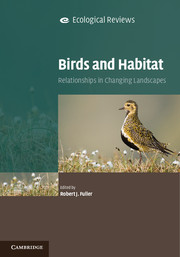Book contents
- Frontmatter
- Contents
- List of Contributors
- Preface
- Part I The complexity of patterns and processes
- Part II Case studies of habitat use and selection
- Chapter Eight Spatial variation and habitat relationships in moorland bird assemblages: a British perspective
- Chapter Nine Arctic-alpine mountain birds in northern Europe: contrasts between specialists and generalists
- Chapter Ten Bird–habitat relationships in reedswamps and fens
- Chapter Eleven Breeding waders on wet grassland: factors influencing habitat suitability
- Chapter Twelve Processes influencing bird use of estuarine mudflats and saltmarshes in western Europe
- Chapter Thirteen Avian habitat use on the non-estuarine intertidal coast
- Chapter Fourteen Temperate western European woodland as a dynamic environment for birds: a resource-based view
- Part III Wider perspectives
- Species index
- Subject index
- References
Chapter Fourteen - Temperate western European woodland as a dynamic environment for birds: a resource-based view
Published online by Cambridge University Press: 05 December 2012
- Frontmatter
- Contents
- List of Contributors
- Preface
- Part I The complexity of patterns and processes
- Part II Case studies of habitat use and selection
- Chapter Eight Spatial variation and habitat relationships in moorland bird assemblages: a British perspective
- Chapter Nine Arctic-alpine mountain birds in northern Europe: contrasts between specialists and generalists
- Chapter Ten Bird–habitat relationships in reedswamps and fens
- Chapter Eleven Breeding waders on wet grassland: factors influencing habitat suitability
- Chapter Twelve Processes influencing bird use of estuarine mudflats and saltmarshes in western Europe
- Chapter Thirteen Avian habitat use on the non-estuarine intertidal coast
- Chapter Fourteen Temperate western European woodland as a dynamic environment for birds: a resource-based view
- Part III Wider perspectives
- Species index
- Subject index
- References
Summary
Woodland bird communities are immensely variable in the number and composition of species and the overall density. Some of this variation is essentially biogeographic. For example, the species pool in most taxonomic and ecological avian groups increases from Ireland through to central Europe (Fuller et al., 2007a). At more local scales, variation is driven mainly by environmental attributes that influence the resources available and consequently determine fitness of individual birds within habitat patches (Holmes, 1990; Chapter 2).
The context for this chapter is long-established woodland in landscapes that have been heavily populated and modified by people for hundreds, even thousands, of years. These woods are predominantly broadleaved, often with a recently introduced coniferous element. Mountain and conifer forests lie outside the scope of the chapter, but for a discussion of northern conifer forests see Chapter 19. In western Europe, a long history of human-related disturbance has produced woodland that is far removed from any ‘natural’ state. Historical interactions between socio-economic processes and environmental factors have produced great diversity of woodland types of varying habitat quality for birds. Regional traditions, differences in management systems and markets, spatial variation in grazing pressure, even neglect, all contribute to this heterogeneity. Whilst some heavily wooded landscapes have persisted, much woodland exists merely as fragments in agricultural landscapes and its plant and animal communities are strongly affected by the surroundings (Chapters 4–6).
- Type
- Chapter
- Information
- Birds and HabitatRelationships in Changing Landscapes, pp. 352 - 380Publisher: Cambridge University PressPrint publication year: 2012
References
- 5
- Cited by



